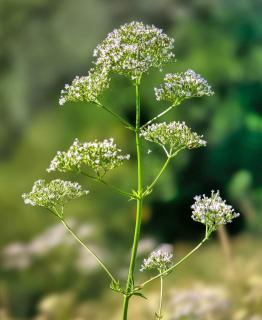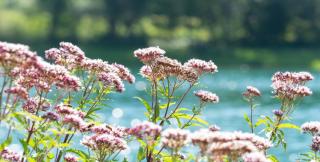

Medicinal valerian is a very fragrant herbaceous perennial known for its cat-attracting properties.
Medicinal valerian fact sheet
Name – Valeriana officinalis
Family – Caprifoliaceae (honeysuckle family), into which the Valerianaceae family was merged
Type – perennial
Height – 24 to 32 inches (60 to 80 cm)
Exposure – full sun
Soil – ordinary
Flowering – May to September
Its beautiful blooming also attracts other animals to your garden: bees.
Fall is the recommended planting season for medicinal valerian. Plant them at a distance of 12 inches (30 cm) from each other.
You may also plant in spring specimens purchased in containers or nursery pots as long as you water a bit more at the beginning.
 Cut wilting flowers off as they die off. The plant propagates very easily through seeds, so if you want to limit its spread, diligently remove wilted flowers before seeds mature.
Cut wilting flowers off as they die off. The plant propagates very easily through seeds, so if you want to limit its spread, diligently remove wilted flowers before seeds mature.
Valerian won’t turn into a woody shrub, so there’s no pruning as such to consider. Every spring, new shoots will appear from either the root crown or the base of the plant.
There are about 200 species of valerian.
Here are a few valerian species of notable interest:
> Still more varieties are Valeriana dioica, Valeriana tuberosa, Valeriana montana…
Not to be mistaken for the garden valerian, Centranthus ruber, medicinal valerian is a herbaceous plant that is also called catgrass.
Medicinal valerian is remarkably easy to grow and it adapts amazingly to any type of soil.
On top of this, it doesn’t require any watering.
Its flowers range in hue from pink to red and will match rocky backgrounds, flower beds as well as pot arrangements or garden boxes.
It is definitely one of the “herbs of old” that our grandmothers knew of, and is a great component of wild gardens.
The roots of medicinal valerian are used in many pharmaceutical preparations.
Medicinal valerian roots seem to have sedative properties. They soothe nervous contractures and insomnia, neurosis or hysteria.
Important note: Valerian is the type species of the Valeriana family. A compound present in all of these plants, valproic acid, acts as a soothing agent.
 Ingesting it during pregnancy (especially the first trimester) resulted in more birth defects (from 1 to 2% more) in the children. Symptoms include spina bifida, polydactyly (extra fingers/toes), atrial septal defect (hole in the heart), hypospadias (an abnormality in the urethra in boys), craniosynostosis and cleft palate. Do not use this herb if pregnant or if you might soon be!
Ingesting it during pregnancy (especially the first trimester) resulted in more birth defects (from 1 to 2% more) in the children. Symptoms include spina bifida, polydactyly (extra fingers/toes), atrial septal defect (hole in the heart), hypospadias (an abnormality in the urethra in boys), craniosynostosis and cleft palate. Do not use this herb if pregnant or if you might soon be!
For a nice ornamental impact, mix the colors.
Really in ancient there is no medicine like now but in olden day flower ,fruit and some other vegetable works as herbs and medicines. i like it your topic very intersting.